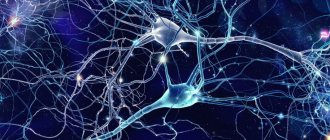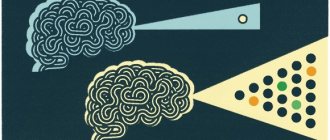Involuntary attention is a variation of attention that occurs due to the influence of a stimulus on the analyzers and consists in reproducing an image, phenomenon, object without the application of volitional effort. This variation of attention is considered its most elementary type, also characteristic of animals. Involuntary attention is observed even in infants, but at first it is unstable and relatively limited in volume. It arises suddenly, autonomously from consciousness, regardless of the type of activity performed at that moment under the influence of various stimuli affecting the body’s analyzer.
Why develop attention?
Insufficiently developed attention skills lead to absent-mindedness, forgetfulness and restlessness. Absent-mindedness will seriously harm a child at school - it will be difficult for him to concentrate in class, concentrate on solving problems and find time to prepare homework. This will also affect the future - in “adult” life it will be difficult for a person to make independent decisions and be truly productive.
If you want to avoid such problems, work with your child and do special exercises together that train the skill of voluntary attention.
Types of attention
Attention can be voluntary or involuntary .
Involuntary attention is inherent in a person from birth. Parents distract a small child by showing him a rattle or grandma's comb; the baby “cries” when he hears music or sees an unusual picture in a book that his mother is reading. Involuntary attention cannot be controlled by consciousness - it arises on its own.
Involuntary attention is formed under the influence of an intense stimulus that evokes an emotional response (loud conversation, bright light bulb, funny children's song, etc.).
For a child's development, training involuntary attention is not enough. In order for any activity, and especially educational activities, to be successful, parents need to focus on the development of voluntary attention.
Voluntary attention arises as a result of a person’s volitional efforts and is controlled by a conscious goal. It is developed as a result of work activity, develops during the formulation and implementation of simple and complex tasks, and is purposeful in nature.
The skill of voluntary attention is necessary for any child. It helps you tune in to solving homework, listen carefully to the teacher, avoid making mistakes, and even set priorities when making a choice in favor of work.
The main function of voluntary attention is the active regulation of mental processes.
Article “CONCEPTS OF ATTENTION IN PSYCHOLOGICAL SCIENCE. INVOLUTIONARY AND ARBITRARY ATTENTION "
UDC 37
CONCEPTS OF ATTENTION IN PSYCHOLOGICAL SCIENCE. INVOLUTIONARY AND VOLUNTARY ATTENTION.
K.A. Trusienko
Lesosibirsk Pedagogical Institute - branch of the Federal State Autonomous Educational Institution of Higher Professional Education "Siberian Federal University"
Lesosibirsk, Russia
Attention is understood as the direction and concentration of mental activity on a specific object while being distracted from others. In other words, attention is the cognitive process of selectively focusing on one object in the world while ignoring others. The first manifestations of attention can be observed already in a newborn, for example, indicative reactions to strong stimuli, and then visual and auditory concentration in order to better perceive the signal [Uruntaeva, G. A. Workshop on the psychology of preschoolers: textbook. aid for students higher professional institutions education / G. A. Uruntaeva. – Moscow: Academy, 2012. – 368 p.].
L.S. Vygotsky emphasizes: “Initial attention is carried out with the help of hereditary nervous mechanisms that organize the flow of reflexes according to the principle of dominance known from physiology” [2].
Attention helps you become more aware of yourself, your thoughts and experiences, since its goal is to improve the functioning of all cognitive processes. Related to this is the fact that attention, unlike other cognitive processes, does not have its own product. Attention often has external and internal manifestations. External ones include a tense posture, a concentrated gaze, while internal ones include changes in the body, for example, increased heart rate, breathing, the release of adrenaline in the blood, etc. [3].
Attention in classical psychology is identified with a clear, distinct area of consciousness. It selects the necessary information from the flow that surrounds a person, ensures selectivity of behavior, and helps maintain constant control over activities.
In cognitive psychology, which studies the process of information processing, attention is associated with a filter, a funnel through which only a limited amount of information passes. Therefore, a person is faced with a choice of which of several objects should be paid attention to or which action should be directed to. The choice of the most significant task depends on the interests of the person, his motives and goals [Martsinkovskaya, T. D. General psychology: textbook. manual for higher students textbook institutions / T. D. Martsinkovskaya. – Moscow: Academy, 2010. –385 p.].
Attention is closely related to activity. S.L. Rubinstein wrote that talking about attention, its presence or absence, can only be done in relation to some kind of activity - practical or theoretical. A person is attentive when the direction of his thoughts is regulated by the direction of his activity, and both directions coincide [5].
Attention ensures the success of the activity and adequate reflection of the object; it is perceived more fully, accurately and qualitatively.
Attention is manifested both in sensory processes (visual, auditory, olfactory, tactile, tactile), where its objects are reality in all its diversity, and in mnemonic, mental processes. Here the objects of attention are memories, ideas of a person, his thoughts, experiences.
The main functions of attention are as follows:
1. selection of significant, relevant (appropriate) information;
2. retention of information to perform an action;
3. regulation and control of the course of action, implementation of automated action of mental control;
4. anticipation (anticipation) of reality, prediction of the results of action, behavior (attitudes, expectations, apperception are manifested here).
K.D. Ushinsky believed that the more attention, the more prepared the consciousness is for the perception and analysis of information. Depending on where the object of attention is located, a distinction is made between external (sensory-perceptual) and internal attention [6].
There are three types of attention: involuntary, voluntary and post-voluntary.
Involuntary attention arises and is maintained regardless of a person’s conscious intentions and is determined by the characteristics of the object, such as novelty, unexpectedness of appearance, strength of impact, degree of significance for the person, and information about the object is stored automatically without any effort. This type of attention can occur even against the will of the individual. For example, although a student is listening to an interesting lecture, a loud sound outside the classroom may attract attention. In some situations, responding to a stimulus becomes a habit.
Thus, a person automatically diverts his attention to this stimulus. For example, a musician's attention is automatically distracted by the sound of music, even if he is engaged in a conversation with someone.
Voluntary attention is attention that requires conscious self-control, volitional regulation of activity and is accompanied by a feeling of effort on oneself, aimed at better performing a particular activity. Voluntary attention occurs when a person sets himself tasks, conscious goals, and is therefore inextricably linked with speech. Also, voluntary attention is closely related to will. Will is a person’s conscious regulation of his actions and actions, which require overcoming obstacles: external and internal.
Therefore, in conditions of difficulties in carrying out activities (I don’t want to, but I have to; time limitation; the actions of distracting stimuli, lack of information, means for carrying out activities), this attention is impossible without volitional efforts and the use of special techniques for concentrating, maintaining, distributing, and switching attention. It is even sometimes called volitional attention.
Post-voluntary attention arises on the basis of voluntary attention, it seems to grow out of it and consists of focusing on an object due to its value and interest for the individual. At the same time, conscious focus is maintained and volitional tension is relieved. Post-voluntary attention does not require effort; the most intense and fruitful mental activity is associated with it [7].
Domestic science examines the problem of voluntary attention from different approaches. Among the leading theories one can note the cultural-historical theory of L.S. Vygotsky, the theory of D.N. Uznadze, who studied attention from the position of attitude psychology.
The activity approach to studying the psychology of attention development includes two research perspectives. Representatives of the first direction consider attention as a property characteristic of any type of activity Ananyev (B.G., Gonobolin F.N., Dobrynin N.F., Rubinshtein S.L.). Attention in this approach is considered as part of a variety of mental processes.
The author of the second approach is P.Ya. Halperin, who considers attention as a special activity of consciousness control. Modern psychological research is devoted to the study of the development of attention in the process of ontogenesis. Among the most famous researchers we can mention I.L. Baskakov, N.P. Diev, S.N. Kalinnikov, Ya.L. Kolominsky, V.A. Krutetsky, N.D. Levitova, A.A. Lyublinskaya.
Human attention is characterized by a number of qualities and properties. The volume of attention is determined by the maximum number of objects that a person can perceive and clearly understand simultaneously per unit of time in connection with some task. Individual differences in attention span are significant. The average attention span is 7 ± 2 units. Attention span, like other mental qualities, can be developed with special exercises and activities.
Distribution is the ability to simultaneously keep several objects and activities in the field of attention, perceive and carry them out equally effectively. A high degree of distribution of attention allows a person to perform a large volume of different actions per unit of time and creates a reserve of time. This characteristic is created as a result of training and depends on the mental and physical state of the person.
Switchability is the transfer of attention from one object to another, from one type of action and activity to another. This property of human attention is manifested in the speed of transferring attention from one object to another, in the speed of inclusion of attention in activity, in the speed of its concentration on a new object, the type of action and the speed of distraction from previous activities and objects. These characteristics of attention are associated with such features of the nervous system as mobility, excitability, and inhibition.
Concentration is the ability of a person to concentrate on the main thing in an activity and distract from the unimportant. The opposite quality of concentration is absent-mindedness. Absent-mindedness is a negative quality of attention. It is a consequence of various reasons: lack of interest, low responsibility for the assigned task, a state of fatigue and tension, illness. In the fight against absent-mindedness, a thorough analysis of its causes is necessary.
Stability is the ability to hold attention on a chosen object for a long time. This feature of attention depends on the characteristics of the human nervous system, on motivation, and external circumstances.
The opposite quality to stability is fluctuation of attention, i.e. a person's inability to concentrate on anything for a long time.
Concentration and stability of attention depend on awareness of responsibility for the activity, a sense of duty, understanding of the meaning of the activity, interest in it, and the volitional qualities of the individual.
So, attention is the cognitive process of selectively focusing on one object in the surrounding world, ignoring others. One of the types of human attention is voluntary attention, which is formed when a person has an interest in some object, activity, or when a certain goal is set for a person, and to achieve this goal it is necessary to make volitional efforts. The main properties characterizing voluntary attention are concentration, stability, volume, distribution and switching. Their development is individual for each person and depends on his personal and age characteristics. The degree of development of attention properties largely determines success in various types of activities.
BIBLIOGRAPHY
- Uruntaeva, G. A. Workshop on the psychology of preschoolers: textbook. aid for students higher professional institutions education / G. A. Uruntaeva. – Moscow: Academy, 2012. – 368 p.
- Vygotsky, L. S. Psychology of human development / L. S. Vygotsky. –Moscow: Meaning; Eksmo, 2005. –1136 p.
- Gurevich, P. S. Personality psychology: a textbook for university students / P. S. Gurevich. –Moscow: Unity-Dana, 2013. –559 p.
- Martsinkovskaya, T. D. General psychology: textbook. manual for higher students textbook institutions / T. D. Martsinkovskaya. – Moscow: Academy, 2010. –385 p.
- Rubinstein, S. L. Fundamentals of general psychology / S. L. Rubinstein. – St. Petersburg: Peter, 2000. –712 p.
- Frolova, P. I. Psychology and pedagogy / P. I. Frolova, A. V. Gorina, M. G. Dubynina. – Omsk: SibADI, 2015. – 429 p.
- Lisina, M. I. Formation of a child’s personality in communication / M. I. Lisina. – St. Petersburg: Peter, 2009. – 320
How is attention formed in children?
There are several factors that influence the speed of formation of the skill of attention during the learning process. Here are some of them:
- individual pace of learning;
- absence of long pauses in the learning process;
- reliance on active mental activity (application of generalization and comparison tasks, searching for examples and drawing conclusions);
- reliance on existing knowledge and skills;
- accompaniment of intellectual activity with special physical activity;
- absence of external stimuli that attract involuntary attention and distract from the cognitive process (loud remarks, comments, sudden movements, music and conversations);
- clarity and brevity of explanations of adults/conditions of the task that needs to be solved.
Causes of involuntary attention
Involuntary attention occurs regardless of the person. He does not control this process, but is only part of it. Many people simplify the process of the emergence of this type of attention, although in fact there are serious psychological, physical, psychophysiological prerequisites and a whole range of reasons hidden here.
A person pays attention to what is more interesting to him
All these reasons can be divided into several groups:
- The nature of the external stimulus. It all depends on the strength and intensity of the impact on a person. Any strong stimulus, such as a bright light, loud music, a strong blow or the sound of a siren, provokes a person to pay attention. It is important that all these stimuli influence a person relative to each other. So, if a person is very passionate about something, say a computer game, he will not notice minor irritants. That is, their level of intensity is not so great as to attract attention. On the other hand, a person may be sensitive to these small stimuli while sleeping or reading.
- Correspondence of stimuli to the internal state and needs of a person. So, for example, an ordinary person and a football fan will react differently to a conversation about the game. The fan will involuntarily notice and react to the dialogue of other people on the topic of football, as well as to various other stimuli affecting this topic.
- Personal attitudes and previous experiences. What a person is most interested in, related to his daily, professional activities and hobbies, always attracts attention, regardless of the degree of importance. Here, as an example, we can cite people who call themselves perfectionists. With such an attitude as “ideality in everything,” a person cannot walk past a crookedly parked car without making a sharp remark to the driver. So a professional photographer will involuntarily be attracted by a beautiful photo on the stand, and he will definitely stop to take a better look at it, and so on.
- Stimuli that affect a person's feelings. What is truly interesting to a person evokes in him a certain range of emotions and feelings. The emotional reaction to various stimuli is the main reason for the emergence of involuntary attention in a person.
Exercises to develop attention for preschoolers
In games for attentiveness for preschool children, emphasis should be placed on the formation of voluntary attention. Parents and teachers need to take into account the psychological and age characteristics of the child, consistently introduce him to new material, and rely on existing knowledge and skills.
Exercise No. 1
Place any object in front of the child - it could be a plush toy or some kind of decorative figurine. Ask him to carefully examine the item for a few minutes, then put the item away. The child should close his eyes and describe the object in as much detail as possible. Then return the item to its place and ask the child to name the “missing” details.
Exercise No. 2
Find a picture that shows several pairs of different objects. One item must be without a pair. Show the picture to your child and ask him to find the item. Here is an example with the heroes of Umnasia:
Exercise #3
“Name the color.” Take a piece of paper and write the names of the colors with markers or pencils that do not correspond to them: for example, the word “red” in black, and the word “yellow” in blue. Show your child what you have done and ask him to name the colors in which the words are written. The child should focus on the color of the font, not on the word for the color.
You can diversify the game and add one word, the color of which will correspond to its meaning (for example, write “green” with a green felt-tip pen). Ask your child to find it among the “wrong” words.
Exercise #4
Show your child a picture that shows several different objects divided into groups: for example, five pots of different colors and seven teapots of different shapes and different colors. Ask your child to carefully study the picture and count how many pots and how many teapots he sees. Here is a good example (albeit, instead of kettles and pots there are cats and dogs):
Exercise #5
Show your child two identical images with small and subtle differences. Ask him to find any discrepancies. You can start right now with this picture:
Description
This is a complex mental process that affects our behavior and the degree of adaptation to the environment. Involuntary concentration is a type of ordinary attention; it appears automatically under the influence of certain factors; it is impossible to keep it under control.
Very often there are moments in our lives when we are involuntarily distracted and closely monitor unusual situations, too loud sounds and strange people. This is how our consciousness brings us into a state of involuntary attention, which is characterized as the simplest form of mindfulness. This concentration is characteristic not only of humans, but also of many animals.
The main feature of such concentration is the absence of conscious choice during the period of its manifestation. When faced with a frightening loud sound, we involuntarily turn our heads in the direction from which it is coming - we cannot control this.
The very first signs of such attention appear in children when they quickly lose interest in some things when other, more interesting ones appear. It is difficult for a child to concentrate on several objects at once, so he is forced to return to the one he likes most.
Also, such concentration can be called passive due to the fact that it appears spontaneously and does not depend on our state. The emergence of this type of mindfulness is influenced by the following factors:
- Objective is a person’s reaction to something new, which surprises with its functions or has an unusual shape.
- Subjective - a manifestation of interest, a tendency towards something. If a person purchased a phone from a certain company, he will involuntarily be attracted to the same thing that he sees from someone else. This is also noticed in the professional sphere - an architect always involuntarily looks at architectural landmarks or facades of beautiful buildings while walking down the street.
With involuntary concentration, we produce a sincere reaction to the situation, an action. The main disadvantage of such attention is that it distracts us from really important matters and solving problems that require full concentration. Also, this type has a bad effect on our productivity.
Exercises for schoolchildren (grades 1-4)
Tasks for schoolchildren improve such characteristics of attention as switchability, distribution and concentration. The child learns to isolate the main thing, “condense” large volumes of educational material into compact diagrams, and control the quality and correctness of the work performed.
Exercise No. 1
Assignment: During a mathematics lesson, teacher Matilda Ilyinichna noticed that Vasya Pchelkin had his head in the clouds and was not listening to the assignment. Approaching his desk, Matilda Ilyinichna saw that Vasya had also drawn stars in his notebook! The teacher at first wanted to give Pchelkin a bad mark, but then she noticed that there was a pattern in the drawings, and even determined how the stars would be located at the place of the gap.
Look at the picture. Can you guess what sequence Vasya followed and which of the listed options he will draw at the place of the pass?
Answer: Let's take a closer look. In the 1st and 2nd rows, remove the top right asterisk from the first picture and get the second picture. We also get the third one. This means that in order to get the third picture in the third row, you need to remove the top two right stars. We get Figure A.
Exercise No. 2
Assignment: Look at the sign and find all the words that are associated with the sea.
Exercise #3
Assignment: This game is called Sudoku. Study the picture carefully. You have four possible heroes. Arrange them in the empty cells of the field so that in each row and in each column not a single hero appears twice.
Exercise #4
Assignment: Koschey Bessmertovich continues to try to destroy humanity. Today he enchanted some words, they were torn into two parts, and now they cannot be used!
All students are busy gluing the pairs back together. Look at the seven half words. Can you help the kids glue them together to make meaningful words? Which half will be left over?
Exercise #5
Look carefully at the picture. Find the missing elements in the block on the right and complete the drawing.











